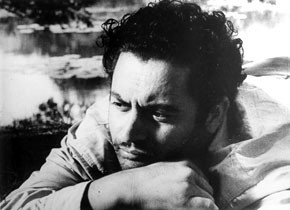Guru Dutt
January 20 to February 3, 2006
The Indian director, actor, producer and choreographer Guru Dutt died on October 10, 1964, following his fifth suicide attempt. His small oeuvre was created in a period spanning just over ten years, yet it still constitutes one of the most important positions in Asian film history.
The Film Museum is now showing Dutt's works for the first time in Austria. In 1947, when Guru Dutt went to Bombay to start a career in films, the young nation of India was just becoming an entity in its current political form. However, at this time there had already been a long history of film on the territory.
Film is the mass medium par excellence in India, far outpacing both radio and printed media. Dutt's contemporaries (Bimal Roy, Mehboob Khan, Raj Kapoor) portrayed India's self-image in the form of social melodrama. They combined elements of Indian mythology, plot and style characteristics of both American and European films, and social messages which established somewhat clichéd notions of Indian life.
Dutt rejected these social clichés and reshaped them into a melancholy, pessimistic representation of the individual and of exclusion from society. He also kept his focus on contemporary imagery and on achieving a genuinely filmic narrative style.
Dutt's native language was Konkani, but he also spoke fluent English, Hindi and Bengali. He felt a particular affinity for the music and literature of Bengal; in contrast to many Bengali filmmakers of his time, however, he never rejected commercial cinema.
He relied heavily on music and choreography, but also gave these “entertainment films” a new dynamic which influenced many filmmakers after him. His use of songs, camera techniques and spoken language was truly innovative. Dialects and sociolects were integrated into the dialogue; the language employed became livelier and more realistic.
Dutt was also the lead actor in his most important films. He plays a caricaturist (Mr. and Mrs. 55), a poet (Pyaasa/Eternal Thirst, 1957) and a director (Kaagaz Ke Phool/Paper Flowers, 1959); in each case, these figures encounter hostility from the society around them.
They are embittered and at the same time inseparably connected to their portrayal by Dutt himself. In the final years of his life, he abandoned directing but continued to be a producer and actor. In the latter métier he had his biggest success following the box office hit Chaudhvin Ka Chand (Fourteenth Day of the Moon, 1960).
The melancholic tenor of Guru Dutt's films is defined by his being a loner, which characterized his whole approach to film art. His masterpieces stem from a complete devotion to work and an involvement in every aspect of production.
Whether it was the screenplay or dialogue writing, the choreography, cinematography or organizational matters, Dutt worked from morning until late at night. His marriage to Geeta Roy, who performs most of the songs in his films, was only initially happy. Dutt was an alcoholic and a victim of severe depression; he took his own life at the age of 39.
The Retrospective will show seven of the eight works which Guru Dutt directed, as well as two films for whose conception and realization his role as producer and lead actor was fundamental. As a complement to these films the Film Museum will show the documentary In Search of Guru Dutt (1989) by Nasreen Munni Kabir.
Daniel Wisser, advisor on this project and a profound connoisseur of Indian films, will give a lecture on Guru Dutt in the framework of the Retrospective. The program was organized with the generous support of the Indian Embassy in Vienna.


